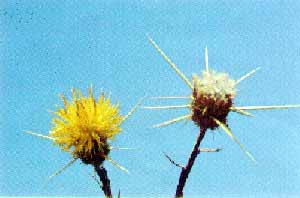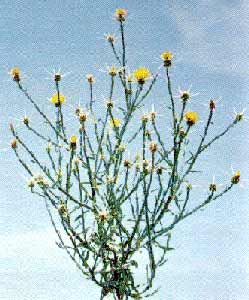 Yellow Star Thistle (YST) is a non-native, aggressive weed that often takes over on poor soils and recently disturbed land. Native to southern Europe, it was introduced by European and Chinese settlers and used primarily for beekeeping and making honey. Yellow Star Thistle (YST) is a non-native, aggressive weed that often takes over on poor soils and recently disturbed land. Native to southern Europe, it was introduced by European and Chinese settlers and used primarily for beekeeping and making honey.
Some exotics introduced to California, such as YST, proved to be very aggressive and produced countless numbers of plants that according to their dominance or persistence have had an impact on native species, in many cases displacing them.
YST is not entirely "bad". It provides nitrogen which enhances the soil, erosion protection, food and cover for some forms of wildlife, forage for cattle (in its early growing stage), and a source for bees to produce honey.
YST is, however, cumulatively poisonous to horses, annoying to people, and appears to produce natural chemical that inhibits the growth of other plant species. It is classified as one of California's most obnoxious weeds. YST is an indicator species for soils that are in poor condition due to lack of fertilizers, compaction and erosion.
Heed these signals and take care of your land and it will take care of you. There are several alternatives currently available for addressing the YST problem:
- BIOLOGICAL CONTROL:
- In the long run, it is believed the best method for broad, general control of YST lies with biological control. At present, the Trinity County Agricultural Commissioner has released several different insect species that feed upon various parts of the plant or seed of YST in Trinity County. So far the results have been promising. These insects multiply quite rapidly and are spreading out over the County. The most promising, at present, is a weevil named Bangasternus orientalis. It will take time to produce sufficient numbers to produce desired results. It is expected that as they become available, other insect species or biological controls will be released by the Agricultural Commissioner's office. While this is an experimental program, its early successes are promising.
For landowners who are interested in reducing present invasions of YST more quickly than the biological control method, the Trinity County Resource Conservation District suggests that one or more of following alternatives be tried.
- MOWING:
- Mowing can either increase or decrease your YST problem, depending on when and how it is done. It is important to mow at the proper time, and mow correctly.
The first mowing should take place just after annual grasses are beginning to dry, the seed is shattering, and (very important) THE YST IS IN ITS BUDDING OR EARLY FLOWERING STAGE, AND NO MORE THAN TWO PERCENT OF THE FLOWERS ARE IN BLOOM. If the plant has not started to bud, it is too early. If it has flowered and the flowers have lost their bright yellow color, it is too late. In either case, you risk increasing the amount of YST.
When mowing, set your blade low enough to remove the flowering tops and buds, but not so low that any returning regrowth will be below your lawnmower's cutting depth. A second mowing will be required in four to six weeks. Follow the same mowing procedures as you did during the first mowing. Sometimes, particularly when enough moisture remains in the soil, and temperatures are still hot, a third mowing will be required.
In following these procedures you will have increased the annual grass seed dispersal and decreased the YST dispersal. Leave the clippings after each mowing. This provides protection for the annual grass seed, organic material for the soil, and shades the YST to reduce growth.
- GRAZING:
- Grazing has been shown to be effective for the control of YST when carried out properly.
, however. Grazing should be carried out using intensive grazing management techniques, (high stocking densities and short grazing periods). Grazing should take place during the "bolting stage" of the YST, usually in May through June. Grazing stock should be returned to graze one to three times at about two week intervals. GRAZING SHOULD NOT TAKE PLACE DURING THE EARLIER "ROSETTE STAGE" (the leaf stage prior to budding), AS THIS WILL INCREASE YST.
- MECHANICAL:
- Where irrigation is available, the site should be irrigated prior to autumn rains to induce early germination. Seedlings should then be disked in. Disk very shallow. Deep tilling or disking will bring buried seeds to surface. When autumn rains do come, newly re-sprouting seedlings should again be disked in, and then the site can be planted with desired grasses.
Mechanical means can also be used in the spring, but tillage must then be deep because the YST will have formed deep tap roots. This will bring buried seeds to the surface which will result in new germination which must be disked under as well. This may have to be done several times before planting with desired grasses.
- MULCHING:
- Mulching requires a considerable amount of material. Wheat Straw, applied 5" thick over YST, in experiments, resulted in 0% return of YST, and a 10% cover of wheat from seeds in the straw. A 5" mulch is equivalent to 500 bales per acre. A 2.5" mulch, 250 bales, resulted in a 78% reduction in YST. Dependence solely upon heavy mulching to control YST is thus recommended only for relatively small patches, or pathways to prevent spreading of YST, or when one has a large volume of mulch to work with. Presumably, mulches of other grasses, or of other organic materials, such as leaves or conifer needles, will provide similar benefits in the reduction of YST.
- CONTROL WITH GRASSES:
- Zorro annual fescue and perennial ryegrass has been found to inhibit YST growth. Wild Oats has been found to be capable of completely eliminating YST. As a result, the Trinity County Resource District recommends using these grasses to help control YST. In lieu of using wild oats, regular feed or seed oats can be used. The shade provided by the grasses appears to play a major role in inhibiting the growth of YST. Because of this, ranchers and those with large areas that need YST control are advised to sow tall grass species such as oats or wheat after tilling in the Autumn, applying fertilizers as required, and watering fields when rains are insufficient.
Ranchers are also advised to cut and bale fields that have been contaminated with YST as opposed to grazing, and to leave a 5" stubble to shade out YST. It is suggested that the cutting and baling not take place prior to May l5, or when grasses are not yet tall enough to leave a 5" stubble.
- BIODIVERSITY:
- Studies have shown that bio-diverse meadows and fields are better able to recover from the effects of disease, fire, drought and other problems. Having at least five different species of plants or more provides the greatest protection.
For this reason, we would recommend that in non-commercial hay or grass fields a mix of native grass seeds of the type of grasses generally found growing locally be sown. Other native plant seeds such as lupines, buckwheats, etc. should be introduced to increase biodiversity. Some of the native grasses that do well in Trinity County are Blue Wild Rye, Nodding Stipa, Pine Bluegrass, Idaho Fescue, California Brome, Slender Hairgrass and Squirrel Tail. For more information about native grasses please call the Resource Conservation District.
- PREVENTION:
- While total prevention is impossible, some measures can be taken to prevent the spread of YST. Do not drive through fields of YST and then drive through thistle free areas. Examine hay or straw for evidence of YST before using the hay for feed, or the straw for mulch. Avoid disturbing the ground as much as possible. When it is necessary to do so, re-seed the ground with desired species and mulch. Try to avoid soil compaction. Aerate ground that is compacted when possible.

Much of the advice given in this pamphlet was obtained from studies and reports compiled by Phil Blake, of the Plant Materials Committee for YST Control which was distributed at a conference, under the title Recent Research and Miscellaneous Literature, Control of Star Thistle. Additional information was obtained from a report titled Star Thistle Control With Grasses, by Craig Carlton Dremann, published by the Redwood City Seed Company. Carl Bishop, Trinity County Agricultural Commissioner also provided information regarding biological control.
We hope that the information that these people obtained through years of research will be of benefit to you in reducing your YST problem. Let us know about your success in achieving these results.
Return to the Trinity County RCD Home Page
|





 Yellow Star Thistle (YST) is a non-native, aggressive weed that often takes over on poor soils and recently disturbed land. Native to southern Europe, it was introduced by European and Chinese settlers and used primarily for beekeeping and making honey.
Yellow Star Thistle (YST) is a non-native, aggressive weed that often takes over on poor soils and recently disturbed land. Native to southern Europe, it was introduced by European and Chinese settlers and used primarily for beekeeping and making honey.